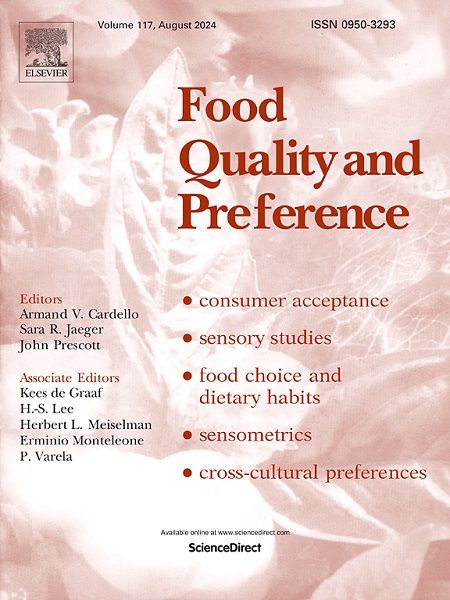我闻到它,我(不想)要它——食物气味对克制和不克制进食者抑制的影响
IF 4.9
1区 农林科学
Q1 FOOD SCIENCE & TECHNOLOGY
引用次数: 0
摘要
我们经常被许多食物暗示所包围,这些暗示会有意识或无意识地影响我们的饮食行为。先前的研究表明,接触食物线索会导致进食不受限制的人抑制能力下降,而进食受限制的人抑制能力增强。然而,这些研究完全是通过视觉领域进行的,使用食物图像作为食物线索。与视觉系统不同,嗅觉系统受到的控制较少,它的效果也不太容易被意识到。因此,本研究调查了食物线索对抑制的影响是否延伸到嗅觉模式。52名女性,26名受约束和26名不受约束的进食者完成了停止信号任务的两个部分:一个是在食物气味(焦糖提取物)的刺激下,另一个是在没有气味的情况下。与无气味条件相比,未受限制组在被食物气味启动时表现出较差的抑制。相比之下,克制进食组在闻到食物气味时表现出比没有气味的组更大的抑制作用。我们的结果重复了先前使用视觉食物刺激的研究,但扩展了文献,表明食物线索和克制进食者之间的联系是强烈的、自动的,并且可能存在于无意识层面。本文章由计算机程序翻译,如有差异,请以英文原文为准。
I smell it, I (do not) want it - the influence of food odor on inhibition in restrained and non-restrained eaters
We are constantly surrounded by many food cues that can influence our eating behaviors, both consciously and nonconsciously. Previous research showed that exposure to food cues leads to decreased inhibition in non-restrained eaters and increased inhibition in restrained eaters. However, these studies were solely conducted using the visual domain, using images of food as food cues. Unlike the visual system, the olfactory system is less controlled, and its effect is less accessible to conscious awareness. Therefore, the current study investigated whether the effect of food cues on inhibition extends to the olfactory modality. Fifty-two females, 26 restrained and 26 non-restrained eaters completed two blocks of the stop-signal task: one while being primed with food odor (caramel extract) and one with no odor. The non-restrained group exhibited poorer inhibition when primed with a food odor compared to the no-odor condition. In contrast, the restrained eaters group showed greater inhibition when primed with a food odor compared to the no-odor condition. Our results replicated previous studies that used visual food stimuli but extended the literature by showing that the association between food cues and inhibition in restrained eaters is strong, automatic, and potentially exists at the nonconscious level.
求助全文
通过发布文献求助,成功后即可免费获取论文全文。
去求助
来源期刊

Food Quality and Preference
工程技术-食品科技
CiteScore
10.40
自引率
15.10%
发文量
263
审稿时长
38 days
期刊介绍:
Food Quality and Preference is a journal devoted to sensory, consumer and behavioural research in food and non-food products. It publishes original research, critical reviews, and short communications in sensory and consumer science, and sensometrics. In addition, the journal publishes special invited issues on important timely topics and from relevant conferences. These are aimed at bridging the gap between research and application, bringing together authors and readers in consumer and market research, sensory science, sensometrics and sensory evaluation, nutrition and food choice, as well as food research, product development and sensory quality assurance. Submissions to Food Quality and Preference are limited to papers that include some form of human measurement; papers that are limited to physical/chemical measures or the routine application of sensory, consumer or econometric analysis will not be considered unless they specifically make a novel scientific contribution in line with the journal''s coverage as outlined below.
 求助内容:
求助内容: 应助结果提醒方式:
应助结果提醒方式:


